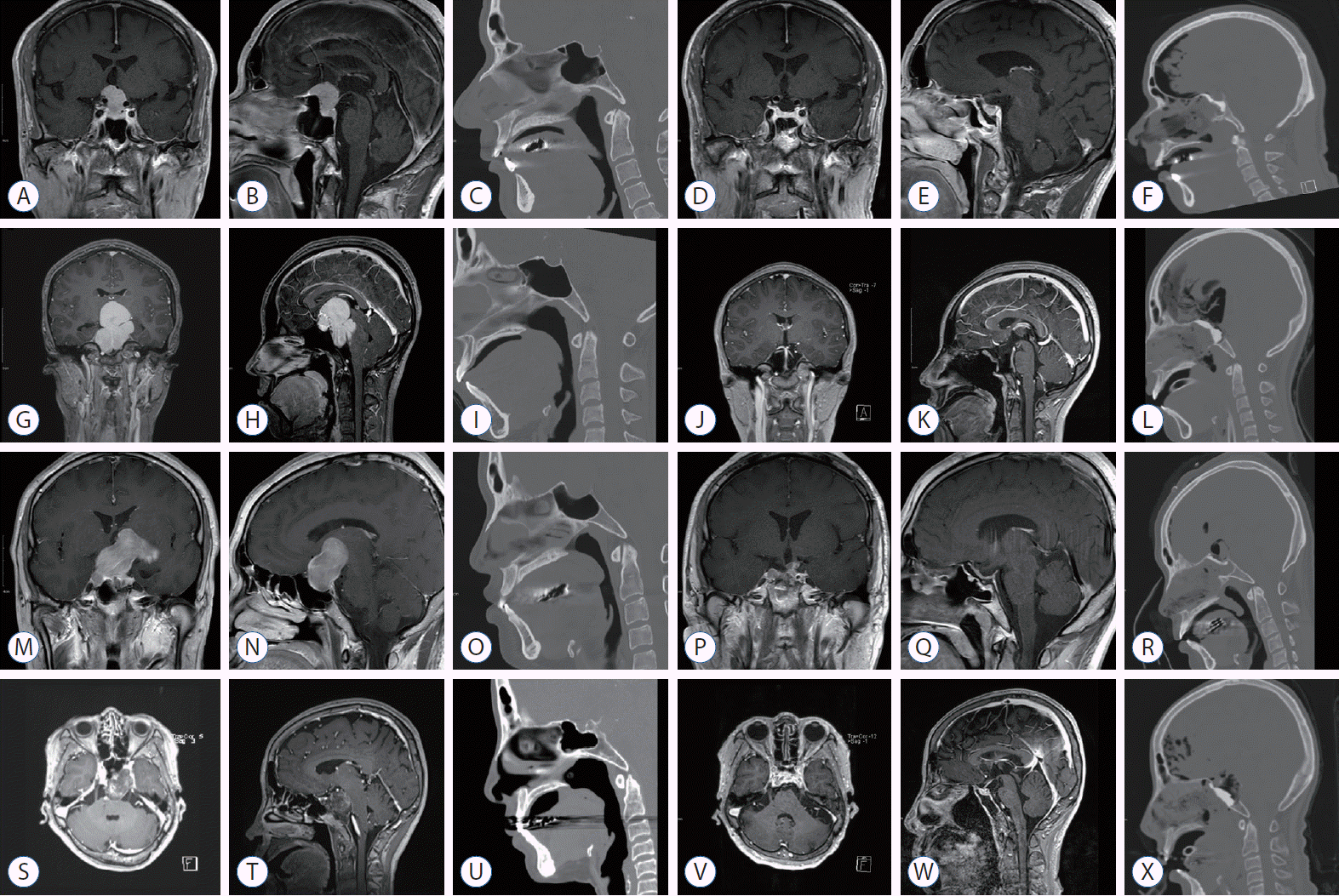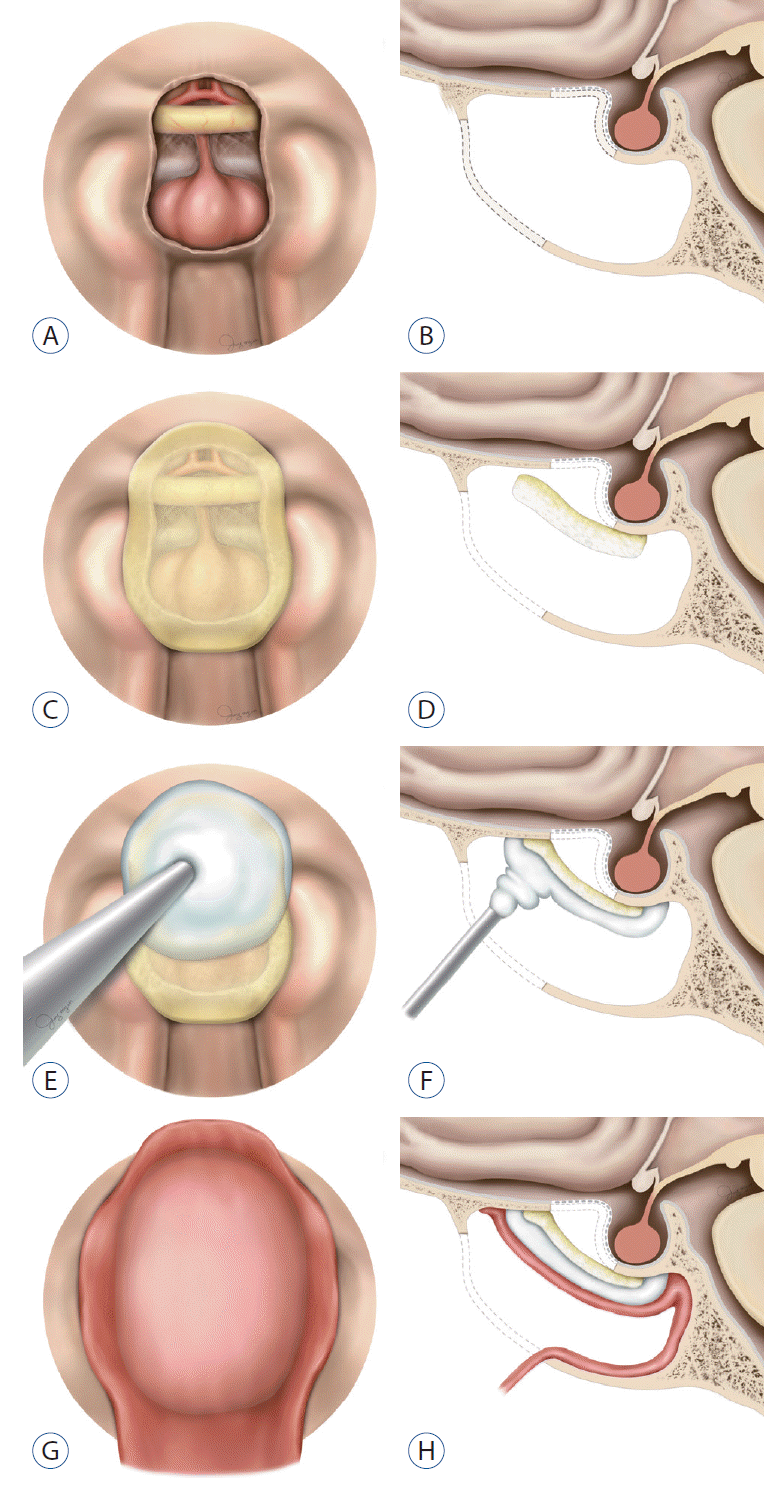1. Abe T, Anan M, Kamida T, Fujiki M. Surgical technique for anterior skull base reconstruction using hydroxyapatite cement and titanium mesh. Acta Neurochir (Wien). 151:1337–1338. 2009.

2. Acerbi F, Genden E, Bederson J. Circumferential watertight dural repair using nitinol U-clips in expanded endonasal and sublabial approaches to the cranial base. Neurosurgery. 67(2 Suppl Operative):448–456. 2010.

3. Ahn JY, Kim SH. A new technique for dural suturing with fascia graft for cerebrospinal fluid leakage in transsphenoidal surgery. Neurosurgery. 65(6 Suppl):65–71. discussion 71-72. 2009.

4. Alvarez Berastegui GR, Raza SM, Anand VK, Schwartz TH. Endonasal endoscopic transsphenoidal chiasmapexy using a clival cranial base cranioplasty for visual loss from massive empty sella following macroprolactinoma treatment with bromocriptine: case report. J Neurosurg. 124:1025–1031. 2016.

5. Arriaga MA, Chen DA. Hydroxyapatite cement cranioplasty in translabyrinthine acoustic neuroma surgery. Otolaryngol Head Neck Surg. 126:512–517. 2002.

6. Ascherman JA, Foo R, Nanda D, Parisien M. Reconstruction of cranial bone defects using a quick-setting hydroxyapatite cement and absorbable plates. J Craniofac Surg. 19:1131–1135. 2008.

7. Battaglia P, Turri-Zanoni M, Castelnuovo P, Prevedello DM, Carrau RL. Brain herniation after endoscopic transnasal resection of anterior skull base malignancies. Neurosurgery 11 Suppl. 3:457–462. discussion 462. 2015.

8. Caggiano C, Penn DL, Laws ER Jr. The role of the lumbar drain in endoscopic endonasal skull base surgery: a retrospective analysis of 811 cases. World Neurosurg. 117:e575–e579. 2018.

9. Cavallo LM, Messina A, Esposito F, de Divitiis O, Dal Fabbro M, de Divitiis E, et al. Skull base reconstruction in the extended endoscopic transsphenoidal approach for suprasellar lesions. J Neurosurg. 107:713–720. 2007.

10. Chabot JD, Patel CR, Hughes MA, Wang EW, Snyderman CH, Gardner PA, et al. Nasoseptal flap necrosis: a rare complication of endoscopic endonasal surgery. J Neurosurg. 128:1463–1472. 2018.

11. Chauvet D, Tran V, Mutlu G, George B, Allain JM. Study of dural suture watertightness: an in vitro comparison of different sealants. Acta Neurochir (Wien). 153:2465–2472. 2011.

12. Chung SB, Nam DH, Park K, Kim JH, Kong DS. Injectable hydroxyapatite cement patch as an on-lay graft for the sellar reconstructions following endoscopic endonasal approach. Acta Neurochir (Wien). 154:659–664. discussion 664. 2012.

13. Conger A, Zhao F, Wang X, Eisenberg A, Griffiths C, Esposito F, et al. Evolution of the graded repair of CSF leaks and skull base defects in endonasal endoscopic tumor surgery: trends in repair failure and meningitis rates in 509 patients. J Neurosurg. 130:861–875. 2018.

14. Dho YS, Kim YH, Se YB, Han DH, Kim JH, Park CK, et al. Endoscopic endonasal approach for craniopharyngioma: the importance of the relationship between pituitary stalk and tumor. J Neurosurg. 129:611–619. 2018.

15. Druel B, Vandenesch F, Greenland T, Verneau V, Grando J, Salord F, et al. Aseptic meningitis after neurosurgery: a demonstration of bacterial involvement. Clin Microbiol Infect. 1:230–234. 1996.

16. Dusick JR, Esposito F, Kelly DF, Cohan P, DeSalles A, Becker DP, et al. The extended direct endonasal transsphenoidal approach for nonadenomatous suprasellar tumors. J Neurosurg. 102:832–841. 2005.

17. Eloy JA, Shukla PA, Choudhry OJ, Singh R, Liu JK. Assessment of frontal lobe sagging after endoscopic endonasal transcribriform resection of anterior skull base tumors: is rigid structural reconstruction of the cranial base defect necessary? Laryngoscope. 122:2652–2657. 2012.

18. Garcia-Navarro V, Anand VK, Schwartz TH. Gasket seal closure for extended endonasal endoscopic skull base surgery: efficacy in a large case series. World Neurosurg. 80:563–568. 2013.

19. Gardner P, Kassam A, Snyderman C, Mintz A, Carrau R, Moossy JJ. Endoscopic endonasal suturing of dural reconstruction grafts: a novel application of the U-Clip technology. Technical note. J Neurosurg. 108:395–400. 2008.

20. George B, Matula C, Kihlström L, Ferrer E, Tetens V. Safety and efficacy of TachoSil (absorbable fibrin sealant patch) compared with current practice for the prevention of cerebrospinal fluid leaks in patients undergoing skull base surgery: a randomized controlled trial. Neurosurgery. 80:847–853. 2017.

21. Germani RM, Vivero R, Herzallah IR, Casiano RR. Endoscopic reconstruction of large anterior skull base defects using acellular dermal allograft. Am J Rhinol. 21:615–618. 2007.

22. Gil Z, Abergel A, Leider-Trejo L, Khafif A, Margalit N, Amir A, et al. A comprehensive algorithm for anterior skull base reconstruction after oncological resections. Skull Base. 17:25–37. 2007.

23. Hanna AS, Grindle CR, Patel AA, Rosen MR, Evans JJ. Inadvertent insertion of nasogastric tube into the brain stem and spinal cord after endoscopic skull base surgery. Am J Otolaryngol. 33:178–180. 2012.

24. Harvey RJ, Parmar P, Sacks R, Zanation AM. Endoscopic skull base reconstruction of large dural defects: a systematic review of published evidence. Laryngoscope. 122:452–459. 2012.

25. Hasegawa H, Shin M, Kondo K, Saito N. Reconstruction of dural defects in endoscopic transnasal approaches for intradural lesions using multilayered fascia with a pressure-control spinal drainage system. World Neurosurg. 114:e1316–e1324. 2018.

26. Heymanns V, Oseni AW, Alyeldien A, Maslehaty H, Parvin R, Scholz M, et al. Sandwich wound closure reduces the risk of cerebrospinal fluid leaks in posterior fossa surgery. Clin Pract. 6:824. 2016.

27. Hoffmann TK, El Hindy N, Müller OM, Schuler PJ, Bergmann C, Hierner R, et al. Vascularised local and free flaps in anterior skull base reconstruction. Eur Arch Otorhinolaryngol. 270:899–907. 2013.

28. Hong CK, Kim YB, Hong JB, Lee KS. Sealing of cerebrospinal fluid leakage during conventional transsphenoidal surgery using a fibrin-coated collagen fleece. J Clin Neurosci. 22:696–699. 2015.

29. Hong SD, Nam DH, Kong DS, Kim HY, Chung SK, Dhong HJ. Endoscopic modified transseptal transsphenoidal approach for maximal preservation of sinonasal quality of life and olfaction. World Neurosurg. 87:162–169. 2016.

30. Huang B, Ren Y, Wang C, Lan Z, Hui X, Liu W, et al. Risk factors for postoperative meningitis after microsurgery for vestibular schwannoma. PLoS One. 14:e0217253. 2019.

31. Hutter G, von Felten S, Sailer MH, Schulz M, Mariani L. Risk factors for postoperative CSF leakage after elective craniotomy and the efficacy of fleece-bound tissue sealing against dural suturing alone: a randomized controlled trial. J Neurosurg. 121:735–744. 2014.

32. Ishikawa T, Takeuchi K, Nagata Y, Choo J, Kawabata T, Ishizaki T, et al. Three types of dural suturing for closure of CSF leak after endoscopic transsphenoidal surgery. J Neurosurg. 131:1625–1631. 2019.

33. Jeon C, Hong SD, Seol HJ, Lee JI, Nam DH, Hwang YJ, et al. Reconstructive outcome of intraoperative cerebrospinal fluid leak after endoscopic endonasal surgery for tumors involving skull base. J Clin Neurosci. 45:227–231. 2017.

34. Kaptain GJ, Vincent DA, Laws ER Jr. Cranial base reconstruction after transsphenoidal surgery with bioabsorbable implants. Neurosurgery. 48:232–233. discussion 233-234. 2001.

35. Kassam AB, Prevedello DM, Carrau RL, Snyderman CH, Thomas A, Gardner P, et al. Endoscopic endonasal skull base surgery: analysis of complications in the authors’ initial 800 patients. J Neurosurg. 114:1544–1568. 2011.

36. Kim YH, Jeon C, Se YB, Hong SD, Seol HJ, Lee JI, et al. Clinical outcomes of an endoscopic transclival and transpetrosal approach for primary skull base malignancies involving the clivus. J Neurosurg. 128:1454–1462. 2018.

37. Kitano M, Taneda M. Icing and multilayering technique of injectable hydroxyapatite cement paste for cranial base reconstruction after transsphenoidal surgery: technical note. Neurosurgery. 61(3 Suppl):E53–E54. discussion E54. 2007.

38. Kong DS, Hong CK, Hong SD, Nam DH, Lee JI, Seol HJ, et al. Selection of endoscopic or transcranial surgery for tuberculum sellae meningiomas according to specific anatomical features: a retrospective multicenter analysis (KOSEN-002). J Neurosurg. 130:838–847. 2018.

39. Koutourousiou M, Fernandez-Miranda JC, Stefko ST, Wang EW, Snyderman CH, Gardner PA. Endoscopic endonasal surgery for suprasellar meningiomas: experience with 75 patients. J Neurosurg. 120:1326–1339. 2014.

40. Kveton JF, Coelho DH. Hydroxyapatite cement in temporal bone surgery: a 10 year experience. Laryngoscope. 114:33–37. 2004.

41. Kveton JF, Goravalingappa R. Elimination of temporal bone cerebrospinal fluid otorrhea using hydroxyapatite cement. Laryngoscope. 110(10 Pt 1):1655–1659. 2000.

42. Lam K, Luong AU, Yao WC, Citardi MJ. Use of autologous fat grafts for the endoscopic reconstruction of skull base defects: indications, outcomes, and complications. Am J Rhinol Allergy. 32:310–317. 2018.

43. Lavigne P, Faden DL, Wang EW, Snyderman CH. Complications of nasoseptal flap reconstruction: a systematic review. J Neurol Surg B Skull Base. 79(Suppl 4):S291–S299. 2018.

44. Leng LZ, Brown S, Anand VK, Schwartz TH. “Gasket-seal” watertight closure in minimal-access endoscopic cranial base surgery. Neurosurgery. 62(5 Suppl 2):ONSE342–ONSE343. discussion ONSE343. 2008.

45. Liu JK, Schmidt RF, Choudhry OJ, Shukla PA, Eloy JA. Surgical nuances for nasoseptal flap reconstruction of cranial base defects with high-flow cerebrospinal fluid leaks after endoscopic skull base surgery. Neurosurg Focus. 32:E7. 2012.

46. Luginbuhl AJ, Campbell PG, Evans J, Rosen M. Endoscopic repair of high-flow cranial base defects using a bilayer button. Laryngoscope. 120:876–880. 2010.

47. Luryi AL, Schutt CA, Michaelides E, Kveton JF. Hydroxyapatite cement cranioplasty for translabyrinthine surgery: a single institution experience. Laryngoscope. 130:206–211. 2020.

48. Matic D, Phillips JH. A contraindication for the use of hydroxyapatite cement in the pediatric population. Plast Reconstr Surg. 110:1–5. 2002.

49. Moon J, Kim N, Kim TJ, Jun JS, Lee HS, Shin HR, et al. Rapid diagnosis of bacterial meningitis by nanopore 16S amplicon sequencing: a pilot study. Int J Med Microbiol. 309:151338. 2019.

50. Moreira-Gonzalez A, Jackson IT, Miyawaki T, Barakat K, DiNick V. Clinical outcome in cranioplasty: critical review in long-term follow-up. J Craniofac Surg. 14:144–153. 2003.

51. Moussazadeh N, Prabhu V, Bander ED, Cusic RC, Tsiouris AJ, Anand VK, et al. Endoscopic endonasal versus open transcranial resection of craniopharyngiomas: a case-matched single-institution analysis. Neurosurg Focus. 41:E7. 2016.

52. Oakley GM, Christensen JM, Winder M, Jonker BP, Davidson A, Steel T, et al. Collagen matrix as an inlay in endoscopic skull base reconstruction. J Laryngol Otol. 132:214–223. 2018.

53. Park JH, Choi JH, Kim YI, Kim SW, Hong YK. Modified graded repair of cerebrospinal fluid leaks in endoscopic endonasal transsphenoidal surgery. J Korean Neurosurg Soc. 58:36–42. 2015.

54. Phi JH, Kim YH, Kim JH, Kim DG. Clinical and anatomic features of supraglandular pituitary adenomas. World Neurosurg. 92:241–248. 2016.

55. Qiao N. Endocrine outcomes of endoscopic versus transcranial resection of craniopharyngiomas: a system review and meta-analysis. Clin Neurol Neurosurg. 169:107–115. 2018.

56. Shorter CD, Connor DE Jr, Thakur JD, Gardner G, Nanda A, Guthikonda B. Repair of middle fossa cerebrospinal fluid leaks using a novel combination of materials: technical note. Neurosurg Focus. 32:E8. 2012.

57. So J, Park H, Sung KS, Lee KS, Hong CK. Sandwich technique using fibrin-coated collagen fleece for sellar reconstruction in large dural defects during transsphenoidal surgery. J Clin Neurosci. 43:256–260. 2017.

58. Soudry E, Turner JH, Nayak JV, Hwang PH. Endoscopic reconstruction of surgically created skull base defects: a systematic review. Otolaryngol Head Neck Surg. 150:730–738. 2014.

59. Tabaee A, Anand VK, Brown SM, Lin JW, Schwartz TH. Algorithm for reconstruction after endoscopic pituitary and skull base surgery. Laryngoscope. 117:1133–1137. 2007.

60. Tews J, Jahromi BR, Ludtka C, Schwan S, Ota N, Meisel HJ, et al. TachoSil dural reconstruction in extracranial-intracranial bypass surgeries. J Neurol Surg A Cent Eur Neurosurg. 80:39–43. 2019.

61. Volsky PG, Hillman TA, Stromberg KJ, Buchinsky FJ, Chen DA, Jackson NM, et al. Hydroxyapatite cement cranioplasty following translabyrinthine approach: long-term study of 369 cases. Laryngoscope. 127:2120–2125. 2017.

62. Yamada S, Fukuhara N, Yamaguchi-Okada M, Nishioka H, Takeshita A, Takeuchi Y, et al. Therapeutic outcomes of transsphenoidal surgery in pediatric patients with craniopharyngiomas: a single-center study. J Neurosurg Pediatr. 21:549–562. 2018.

63. Zwagerman NT, Geltzeiler MN, Wang EW, Fernandez-Miranda JC, Snyderman CH, Gardner PA. Endonasal suturing of nasoseptal flap to nasopharyngeal fascia using the V-Loc™ wound closure device: 2-dimensional operative video. Oper Neurosurg (Hagerstown). 16:40–41. 2019.

64. Zwagerman NT, Wang EW, Shin SS, Chang YF, Fernandez-Miranda JC, Snyderman CH, et al. Does lumbar drainage reduce postoperative cerebrospinal fluid leak after endoscopic endonasal skull base surgery? A prospective, randomized controlled trial. J Neurosurg. 131:1172–1178. 2019.







 PDF
PDF Citation
Citation Print
Print




 XML Download
XML Download